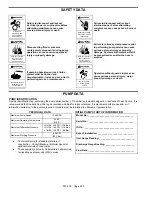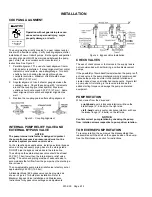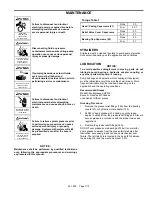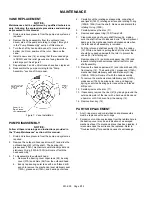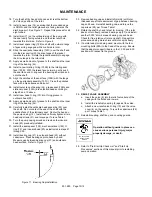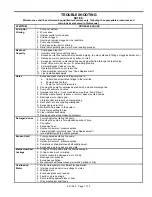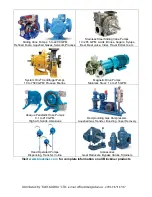
501-K00 Page 3/12
INSTALLATION
NOTICE:
Blackmer pumps must only be installed in systems
designed by qualified engineering personnel. System
design must conform with all applicable regulations and
codes and provide warning of all system hazards.
NOTICE:
This pump shall be installed in accordance with the
requirements of NFPA 58 all applicable local, state and
national regulations.
Install, ground and wire to local and
National Electrical Code requirements.
Install an all-leg disconnect switch near
the unit motor.
Disconnect and lockout electrical power
before installation or service
Electrical supply MUST match motor
nameplate specifications.
Hazardous voltage.
Can shock, burn or
cause death.
Motors equipped with thermal protection automatically
disconnect motor electrical circuit when overload exists.
Motor can start unexpectedly and without warning.
PRE-INSTALLATION CLEANING
NOTICE:
New pumps contain residual test fluid and rust inhibitor.
If necessary, flush pump prior to use.
Foreign matter entering the pump WILL cause extensive
damage. The supply tank and intake piping MUST be
cleaned and flushed prior to pump installation and operation.
LOCATION AND PIPING
Pump life and performance will be significantly reduced when
installed in an improperly designed system. Before starting
the layout and installation of the piping system, review the
following suggestions:
1. Locate the pump as near as possible to the source of
supply to avoid excessive inlet pipe friction.
2. The inlet piping and fittings should be at least as large as
the intake port on the pump. It should slope downward to
the pump, and should not contain any upward loops.
Minimize the number of intake line fittings and eliminate
restrictions such as sharp bends; globe valves,
unnecessary elbows, and undersized strainers.
3. A strainer must be installed in the inlet line to protect the
pump from foreign matter. The strainer should be located
at least 24" (0.6m) from the pump, and have a net open
area of at least four times the area of the intake piping.
Strainers must be cleaned regularly to avoid pump
starvation. (Strainers are optional when pumping from
underground tanks.)
4. The intake and discharge piping system must be free of
all leaks.
5. Expansion joints, placed at least 36" (0.9m) from the
pump, will compensate for expansion and contraction of
the pipes. Contact the flexible connector/hose
manufacturer for required maintenance/care and design
assistance in their use.
6.
ALL piping and fittings MUST be properly supported to
prevent any piping loads from being placed on the pump.
7. Check alignment of pipes to pump to avoid strains which
might later cause misalignment. See Figure 1. Unbolt
flanges or break union joints. Pipes should not spring
away or drop down. After pump has been in operation
for a week or two, completely recheck alignment.
Figure 1
8. Install pressure gauges in the NPT ports provided in the
pump casing to check pump performance at start up.
9. The use of a 1.5” or 2” vapor return line will speed
delivery by preventing pressure build up at the receiving
tank and pressure reduction in the supply tank.
10. Keeping the liquefied gas systems full of liquid, even
when idle, will keep the O-rings from changing shape,
shrinking or super cooling. Evaporation of liquefied gas
leaves an abrasive powder on the surface which can
cause wear to the pump, meter, and seals.
PUMP MOUNTING
Permanently mount the unit by securing the base plate with
adequately sized anchor bolts to a level concrete floor
following recommended industry standards (See Figure 2). A
solid foundation will reduce system noise and vibration, and
will improve pump performance. Refer to ANSI/HI standards
or a suitable pump handbook for information on typical pump
mounting and foundations. Check coupling alignment after
pump and base assembly is secured to the foundation.
BOLT
BASE
STANDARD
PIPE
WASHER
Figure 2. Foundation Anchor
When installing units built on channel or structural steel type
bases, use care to avoid twisting the base out of shape when
anchor bolts are tightened. Shims should be used under the
edges of the base prior to tightening of the anchor bolts to
prevent distortion.


